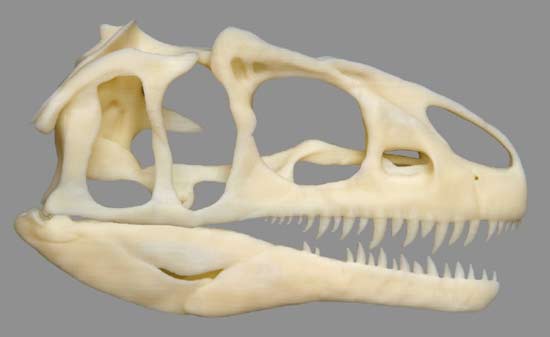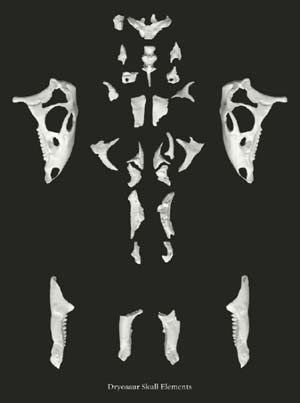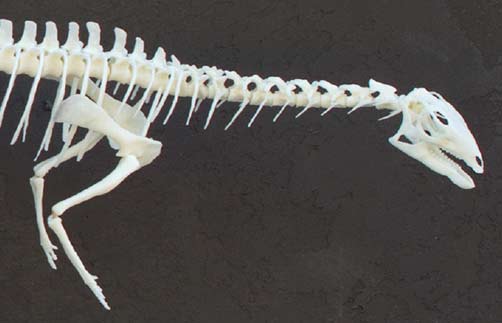Museums have been finding that through 3D printing, they can achieve several key tasks. For one, they can allow for the reproduction of rare and expensive pieces, and then permit museum-goers to get close and even touch those reproductions. Secondly, they have been able create a hands-on experience for those at home, who can’t always make it out to the actual museum. By putting 3D models online, viewable and 3D printable on a  common desktop 3D printer, an entirely new method of appreciating rare artifacts has been brought forth.
common desktop 3D printer, an entirely new method of appreciating rare artifacts has been brought forth.
When I was a kid, probably the thing that excited me the most when visiting the Smithsonian Museums in Washington D.C., were the dinosaur exhibits. Especially when dealing with dinosaur fossils, museums like to create reproductions so that the actual bones may remain in a safe place, while the replicas are available, sometimes unprotected, allowing for interaction with guests. What many of us don’t realize, however, is the difficulty paleontologists have in reproducing such large, and often extremely detailed fossils.
The typical process involves several complicated, time-consuming steps, such as sculpting the bones out of clay, creating silicone molds, and then casting the bones from a resin. After all this, the replicas are usually not exact, as they have relied on hand sculpting.
Where complicated processes are involved in the manufacturing of plastic objects, 3D printing can usually be an awesome alternative. This is just what paleontologist Jeffrie Parker, of Western Paleo Labs, and Kirk Brown, a Stratasys reseller at GoEngineer, did in their collaboration.
Parker wanted to create a replica of a Dryosaurus which he had uncovered in Wyoming. He wanted a large model of the creature, which typically is not something 3D printers are capable of. However, the two men were able to break a scanned model up into 20 different STL files, which when combined, would equate to a replica measuring a staggering 50 inches in length and 15 inches in height.
“I like having a project like this to work on because it’s nice when we work on living history and open up our eyes to the endless possibilities of 3D printing,” Brown explained to the Stratasys blog.
The men used a Stratasys uPrint SE Plus, to print all 20 pieces, two times a piece, in a an ivory ABSplus material. Two times because Brown wanted a model for inside the Goengineer office, and naturally Parker wanted a model as well.
“3D printing allows a paleontologist to quickly reproduce a fossil bone that can be used for academic study and for building museum exhibits that can be enjoyed by everyone,” stated Parker. “Having a 3D printer is like having your own little robot factory.”
The models turned out amazing, prompting Parker to set his sights on an even larger project. He next will create a Jurassic period 3D printed tableau, featuring the Dryosaurus, along with three other dinosaurs, two Allosaurs and a Ceratosaur.
“When I 3D print this group of four dinosaurs and build the exhibit, this will show the museum world what 3D printing can do!”
If they haven’t already realized the potential that 3D printing brings to the table, such a feat will certainly do it, you would think. I am just waiting for the first 3D printed life-size Tyrannosaurus… One day, right?
Let’s hear your thoughts on Parker and Brown’s incredible use of 3D printing in the 3D Printed Dryosaurus forum thread on 3DPB.com.
Subscribe to Our Email Newsletter
Stay up-to-date on all the latest news from the 3D printing industry and receive information and offers from third party vendors.
You May Also Like
Gorilla Sports GE’s First 3D Printed Titanium Cast
How do you help a gorilla with a broken arm? Sounds like the start of a bad joke a zookeeper might tell, but it’s an actual dilemma recently faced by...
Nylon 3D Printed Parts Made More Functional with Coatings & Colors
Parts 3D printed from polyamide (PA, Nylon) 12 using powder bed fusion (PBF) are a mainstay in the additive manufacturing (AM) industry. While post-finishing processes have improved the porosity of...
$25M to Back Sintavia’s Largest Expansion of Metal 3D Printing Capacity Since 2019
Sintavia, the digital manufacturing company specializing in mission-critical parts for strategic sectors, announced a $25 million investment to increase its production capacity, the largest expansion to its operations since 2019....
Velo3D Initiates Public Offering in a Bid to Strengthen Financial Foundations and Drive Future Growth
Velo3D (NYSE: VLD) has been among a number of publicly traded 3D printing firms that have attempted to weather the current macroeconomic climate. After posting a challenging financial report for 2023,...

































